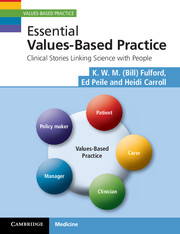Book contents
- Frontmatter
- Review quotes
- Contents
- Foreword
- Acknowledgements
- A bold claim to start this book
- Prologue: linking science with people
- Part 1 Values, individuals and an overview of values-based practice
- 1 “It's my back, Doctor!” (episode 1): values and clinical decision-making
- 2 “It's my back, Doctor!” (episode 2): applying the tools already in the clinical toolbox for working with values to individuals
- 3 An outline of values-based practice: its point, premise and ten-part process
- Part 2 The clinical skills for values-based practice
- Part 3 Relationships in values-based practice
- Part 4 Science and values-based practice
- Part 5 Bringing it all together
- Postcript: the small change of care
- A bold claim to end this book
- Appendix A Values-based practice summary and definitions of key terms
- Appendix B Values-based practice teaching framework
- Index
2 - “It's my back, Doctor!” (episode 2): applying the tools already in the clinical toolbox for working with values to individuals
Published online by Cambridge University Press: 05 June 2012
- Frontmatter
- Review quotes
- Contents
- Foreword
- Acknowledgements
- A bold claim to start this book
- Prologue: linking science with people
- Part 1 Values, individuals and an overview of values-based practice
- 1 “It's my back, Doctor!” (episode 1): values and clinical decision-making
- 2 “It's my back, Doctor!” (episode 2): applying the tools already in the clinical toolbox for working with values to individuals
- 3 An outline of values-based practice: its point, premise and ten-part process
- Part 2 The clinical skills for values-based practice
- Part 3 Relationships in values-based practice
- Part 4 Science and values-based practice
- Part 5 Bringing it all together
- Postcript: the small change of care
- A bold claim to end this book
- Appendix A Values-based practice summary and definitions of key terms
- Appendix B Values-based practice teaching framework
- Index
Summary
Topics covered in this chapter
Continuing the story of Dr. Gulati and Roy Walker, this chapter takes us to the starting point for values-based practice in the complex values involved in individual clinical decision-making.
Other topics include:
Codes of ethics
Principles reasoning
How values and ethics fit together
Decision analysis
How values and evidence fit together
Clinical judgment.
Take-away message for practice
All current tools need the application of individual clinical judgment and up until now there has been little to guide clinicians on processes to find the best solutions for individual cases.
In this chapter, we take the story of Roy Walker and Dr. Gulati a stage further. The doctor turns for help to a number of tools in medicine's values toolbox: first, codes of practice and ethics, then decision analysis and finally evidence-based practice. These all prove helpful but only up to a point, for when applied to the particular circumstances of the patient, each of them raises but fails to resolve a number of complex values issues.
It is these and similar complex values issues raised by clinical decision-making between individual patients and individual clinicians that take us to the starting point for values-based practice.
What to do?
We start this chapter with a suggested reflection aimed at helping us to get away from general ethical theorizing about what Dr. Gulati ought to do and to focus rather on what she could do in the particular circumstances in which she found herself on a Monday morning at the start of a busy clinic.
- Type
- Chapter
- Information
- Essential Values-Based PracticeClinical Stories Linking Science with People, pp. 11 - 23Publisher: Cambridge University PressPrint publication year: 2012



